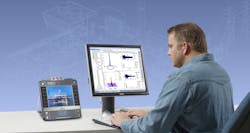Big Data. We’ve all heard about it. These days, it seems to be the Holy Grail of process control. But don’t kid yourself. It’s not a magic pill. It’s not something easily attained, and it’s not something easily digested.
I’ve talked here before about how you might be able to gather the data, but actually putting it to work for you is likely a different matter. Well, according to the folks at Emerson Process Management, don’t be fooled into thinking that gathering the data is such an easy matter either.
The Internet of Things that people like to talk about relies on massive amounts of sensor data from around the plant. We have heard about GE’s Industrial Internet and Cisco’s Internet of Everything. “They assume the data magically appears,” lamented Peter Zornio, chief strategic officer for Emerson Process Management. “In process industries, that’s a big deal.”
Emerson execs have talked quite a bit about “pervasive sensing” this week at the Emerson Global Users Exchange in Grapevine, Texas. It’s what they’re calling the trend toward collecting massive amounts of data from around a facility or production process.
Pervasive sensing has already been prevalent around process safety and process control—checking pressures, temperatures, levels, flows, etc.—but now it’s being moved into such business-critical areas as site safety, reliability and energy efficiency as well. “Those business-critical issues are all becoming more important,” says Steve Sonnenberg, president of Emerson Process Management. “At the same time, the cost of sensing is becoming cheaper because of wireless technology.”
More sensors mean more data, of course. But how can you put all that information to work? “We’re working on providing you not just with data, but with actionable data,” Sonnenberg said.
When the business-critical aspects are added to the process data being commonly collected already, it will probably double the number of sensors manufacturers have in their facilities, according to Zornio.
Emerson has a vision of pervasive sensing underpinning industrial facilities, Zornio said, using innovative sensors that are easily commissioned and that require no maintenance. Such pervasiveness has been held back in the past by the cost and difficulty of sensor deployment, technology complexity, immeasurable processes, data access and interpretation, and resource priorities, Zornio said. But today, several factors are bringing about a change: innovative sensors, wireless communications, power technology, advanced analytic capabilities, embedded expertise, and mobile and location technologies.
Charlie Peters, Emerson’s senior executive vice president and “chief innovation officer,” makes a differentiation between Big Data and Little Data, Zornio said. The idea with Big Data is that if you collect massive amounts of it, you’ll figure something out. You can study all this data, and find trends.
Little Data, on the other hand, is for targeted applications; targeted data for finding out very specific information for something you’re trying to achieve. You know what you want to measure, and you measure it.
“In process industries, we’ve had Big Data for years, but people are not really sure what to do with that,” Zornio said. “You’re so much better off knowing what you’re trying to find out, instead of just collecting a bunch of data.”
An example of Little Data comes from Nick Jude, rotating equipment reliability engineer at Flint Hills Resources in Pine Bend, Minn. This 320,000 BBL/D refinery processes high-sulfur heavy crude. A process hazard analysis (PHA) at the refinery showed that they had 110 high-risk pumps that could be subject to vapor cloud release and explosion. They wanted to get the data they needed to monitor those pumps, and chose wireless vibration monitoring for early fault detection.
The No. 1 priority for this project was safety. The CSI 9420 wireless vibration transmitters from Emerson gave Flint Hills the data they needed to know at any given time whether a pump needed to be shut down. With just one such situation, Flint Hills had achieved its objectives with the data. “The alarms have been turned on about eight months now,” Jude said. “And we’ve found three or four similar situations.”
Another good use of Little Data came for Fluor Global Services Division, which makes refrigerated and frozen dough, and yogurt at its facility in Murfreesboro, Tenn. The goal was to reduce energy usage. Failed steam traps were a huge culprit, according to Richard Luneack, project coordinator for Fluor, who described a plant with hundreds of steam traps that received only annual inspection.
“In one maintenance check, 22% of our traps needed replacement,” he noted. “How do you know that it didn’t fail the moment you walked away? There’s no way to know.” So in theory, a failed trap could leak steam for up to a year before its next inspection, he added.
Assuming a loss of 12,000 pounds of steam per day, it could be costing Fluor as much as $36,000 a year, making it easy to justify real-time steam trap monitoring, Luneack said. Fluor went with Rosemount 708 wireless acoustic transmitters. “The software package gives users a dashboard view of all the traps at same time,” he said. “So you can tell with just a glance the status of the traps.”
It’s the relatively low cost of wireless technology, in fact, that has made the cost equation a winning one to increase data gathering throughout many facilities. Flint Hills, for example, probably would’ve been able to afford only 10-15 pieces of equipment previously, Jude said. “With the wireless vibration technology, we could do all 110 pumps.”
And, he added, they really couldn’t afford to not install the wireless technology. “A pump can destroy itself in less than 30 days,” Jude said. “We couldn’t afford to have somebody walking around and checking as often as they’d need to.”
And, brought together over time, Little Data becomes Big Data. “We’ll be able to learn a lot more over time,” Sonnenberg said. Looking over a five-year period, for example, might show that a particular type of part is prone to failure. “That’s Big Data,” Zornio added.

